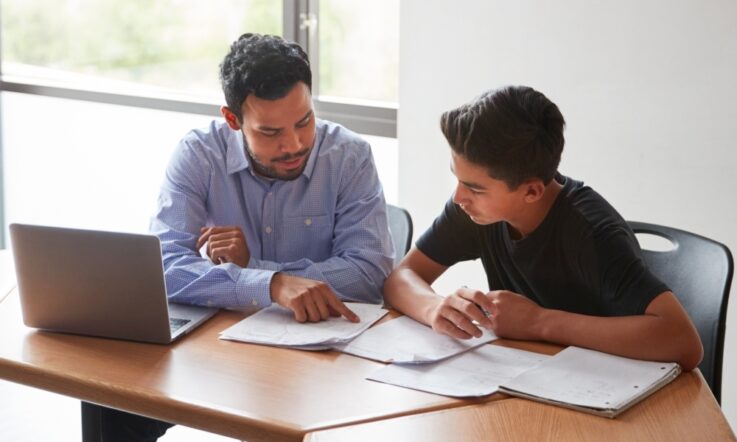Last week we published an article on small group tutoring discussing how to identify students who have fallen behind during the period of remote learning due to COVID-19, and why school leaders have a critical role in co-designing small group tutoring programs in their schools. In today’s article, we explore how to choose a tutor to best suit your students’ learning needs, the professional learning offered to tutors, and why a collaborative relationship between the classroom teacher and tutor teacher is critically important.
Small group tutoring has emerged as a key strategy to support students who fell behind in 2020 during remote schooling, with governments around the country pledging support for initiatives in their states and territories.
In June 2020, Dr Julie Sonnemann and Dr Peter Goss from the Grattan Institute co-authored a report that estimated nearly 100 000 tutors are needed to help one million disadvantaged students across Australia catch up on their learning.
‘Given the large number of tutors needed, extra staff beyond teachers would be required,’ the report reads. ‘We suggest tutors be drawn from various groups, including teaching staff who have the time, as well as non-teaching staff such as teaching assistants, university graduates, and pre-service teachers. Drawing tutors from various groups would ensure teachers are not over-burdened during the recovery phase.’
Selecting a tutor
Sonnemann says that when it comes to selecting a teacher tutor that meets the needs of your students, there are some basic tutor competencies that schools should look for.
‘It’s important to look for tutors who have good communication skills, good planning skills, a good understanding of the role and what it involves,’ Sonnemann tells Teacher.
Drawing on aspects of the catch-up tutoring model adopted in the UK, Sonnemann says that it can be useful to look for tutors will skillsets in specific subject areas.
‘So, if students are struggling in maths, then obviously you want a tutor who can help with maths. In the UK, for example, they’ve got some benchmarks requiring that the tutors have good grades in the subjects in which they’re tutoring. An in-depth understanding of the subject I think will always hold someone in good stead,’ she says.
In Victoria, the government pledged $250 million for 4100 tutors to be deployed in the state’s schools. Karen Money is principal of Melbourne Girls’ College in Victoria, and this year she’s been seconded to lead the Victorian Department of Education and Training’s Tutor learning initiative.
She says that school leaders are given the flexibility to choose tutors to best meet the needs of their students. Tutors may be pre-service teachers, a teacher on leave, a teacher working part-time who is looking for more hours, a recently retired teacher, or a casual relief teacher (CRT).
‘I would say at least 50 per cent of principals readily identified someone who was either recently retired or underemployed in their school, or a good CRT that had worked regularly with their school and identified them as the right people to work with their identified students,’ Money says.
The other 50 per cent, according to Money, are already fully staffed and don’t have a network of potential tutors, so decided to use the Victorian Government’s recruitment tool Recruitment Online, to select from a pool of potential tutors.
‘They could use a filter in that pool to download towards their area, to the expertise they wanted, and from that pool provide a shortlist for them to go through – a government selection process that’s in line with the Victorian Government’s Schools Agreement 2017.’
Teacher and tutor working collaboratively
Money says there is an expectation that classroom teachers and tutor teachers work closely together to ensure that students are achieving success in the program.
‘These tutors are trained teachers, they work under the same agreement as a teacher, so the expectations for collaboration with your colleagues and meeting schedules and all of those sorts of things are all exactly the same for our tutors,’ she says.
Money says if she was still working in her school context as principal, she’d be ensuring that the tutor teachers were working closely with the classroom teachers in their professional learning teams.
‘I would be putting the tutor teacher into the professional learning teams with the classroom teachers they’re working with, and then they can cross-pollinate in a meeting time around what it is they’re working on, where the students are at, analysing the students’ data, analysing the individual education plan, and using that meeting schedule.’
For Sonnemann, effective implementation means tutors should be working closely with teachers to ensure their tutoring is closely linked to normal teaching.
‘Tutoring should be linked with what’s happening in the classroom and the teacher and the tutor working together and monitoring progress,’ she tells Teacher.
Professional learning for tutors
Tutor teachers will require intensive training to ensure they’re able to meet to the students’ learning needs, and are able to give targeted feedback.
In Victoria, Money says tutor teachers will have access to this training via learning modules as part the Middle Years Literacy and Numeracy Support (MYLNS) initiative.
‘We’ve just engaged a professional learning team who’s job is to audit the different modules that are in MYLNS and are suitable for small group tutoring, so that it isn’t up to our tutor teachers to just go on this website and find what’s appropriate for themselves,’ Money says.
The appropriate modules will be brought across to a small group tutoring platform so that the tutor teacher, the classroom teacher and the school improvement team will all be using the same platform to deliver the high quality small group tutoring. Money says tutor teachers will also be trained in how to engage learners in a small group setting, how to build individual education plans for students, and how to work with parents and other supports to ensure that students are at the centre of this work.
‘There will be another module on how to deliver in that small group setting and make sure that each young person in that small group has the opportunity to ask their specific questions and feel that they’re nurtured and cared for by the teacher tutor,’ she adds.
The modules were made available from late January to ensure that tutor teachers can access them online during their preparation and professional learning time. Tutor teachers will also be notified as new modules are released.
Stay tuned: In the final installment of this tutoring series, we’ll be taking a close look at what effective small group tutoring looks like in practice, the importance of building relationships with students, and why students need to be at the centre of this work.
References
Sonnemann, J., & Goss, P. (2020). COVID catch-up: helping disadvantaged students close the equity gap. Grattan Institute.
As a school leader, how have you gone about choosing the right tutor teacher for your school context? How will you support their induction into your school community?
As a classroom teacher, how will you ensure that you’re working collaboratively with the tutor teacher in your classroom? How will you use meeting times to maximise this working relationship?



